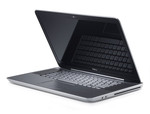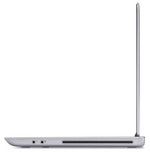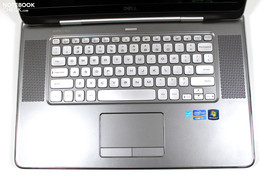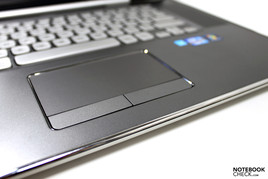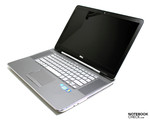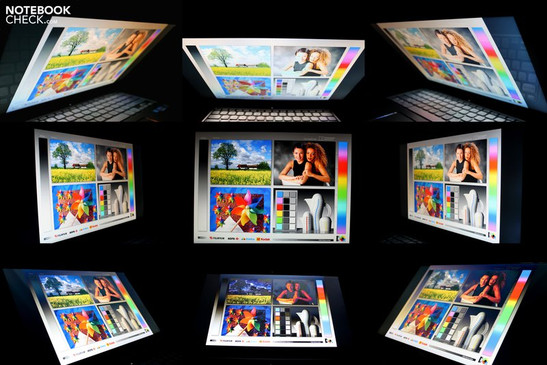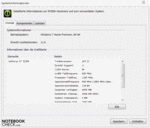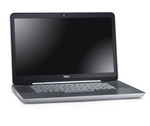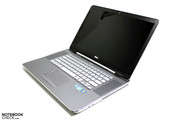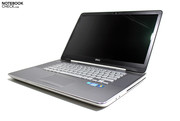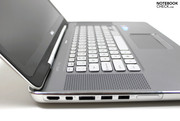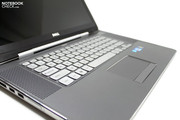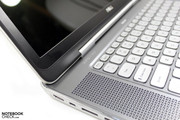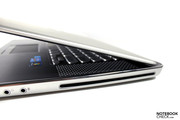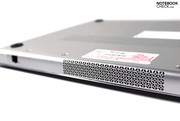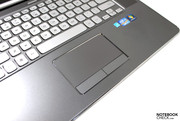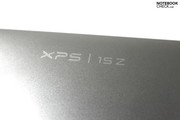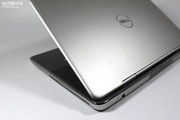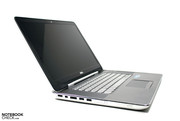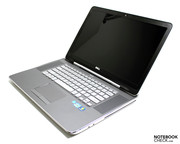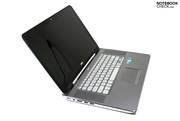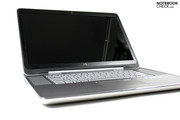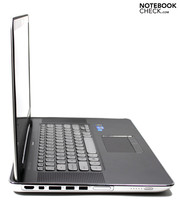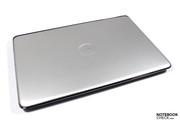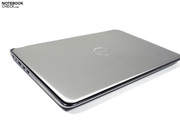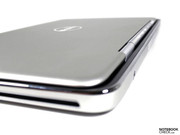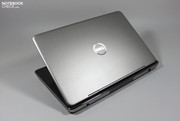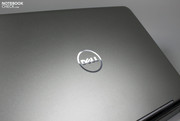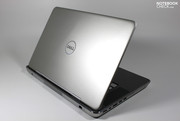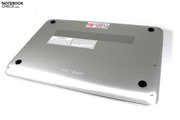Review Dell XPS 15z Notebook

Would you call yourself a "rising star"? Yes? No? I'm not sure? Well, Dell sees the targeted consumer group for the new XPS z-series precisely in this audience. "Heavy business use and light entertainment" – with a touch of luxury is to be the new notebooks' main applications field. Is it big talk or a real challenge to the competition, possibly even from the Apple corner? We're taking a closer look at the first representative from the series, the 15 inch XPS 15z, with an almost completed pre-sample.
Case
Dell has previously offered quite a bit in terms of materials, design and stability. The 15z now wants to do an even better job, and in our opinion, also succeeds. Plastic parts have been banned completely from its appearance. Virtually all visible and palpable surfaces are made of aluminum. Coated in a lighter (exterior) and somewhat darker silver nuance (interior), and with the circumferential chrome strip, the not even 25 millimeter high device (closed) presents itself very stylish and stays pleasantly reserved at the same time. No matter if it's on a glass top or precious wood desk, or even on the genuine leather couch, the XPS 15z will look good in almost every setting.
We particularly like the fact that the XPS 15's idiosyncratic design is no longer used on the 15z and it is allowed to nicely and plainly run towards the back. The base unit presents a slightly visible wedge shape that is, however, only caused by the chrome strips that increase towards the back. Thus, the keyboard is practically even with the surface.
A perforated structure adorns the base unit on the keyboard's right and left. The stylized X notches are known in a similar form from various other XPS models. The notebook's loudspeakers are behind these openings and can emit their sound directly toward the user.
The display has been placed a bit further front on the base unit. This peculiarity has become a main recognition feature of almost all Dell notebooks in the meantime. It also limits the opening angle to about 130°. This shouldn't cause any problems during use, though.
An unbroken rubber lip that closes flush on the base lid runs around the lid. It is supposed to prevent dirt particles from intruding (greetings from Apple). There is no security latch for transportation. However, the closing force of both centrally placed hinges isn't quite high enough to keep the display in position when the notebook is turned upside down.
Connectivity
Even if the side edges don't look like the ones in the normal XPS series, Dell agreeably sticks to the mindfully placed interfaces rather more towards the rear area. It can reduce annoying cables beside the laptop when the ports are used extensively. And anyway, almost all interfaces are grouped on the left side's edge in the rear. Besides HDMI (1.4a), a mini display port, a USB/eSATA combo socket and two USB 3.0 ports, you'll also find a cardreader that supports numerous formats (9in1).
The charge indicator of the irremovably built-in battery on the left, the slot-in drive on the right and two separated 3.5 mm jacks for headphone and microphone on the right front is also worth mentioning here. Overall, the XPS 15z has everything that an up to date, all-round notebook needs in our opinion. Merely the lack of a BluRay drive can be criticized on the Dell XPS 15z. According to Dell, there was simply no matching unit available that would have fit into the especially slim drive slot. The design orientated user will be able to live without an ExpressCard slot since an ugly, thick inserted card would ruin the XPS 15z's looks.
Communication
Dell isn't stingy when it comes to communication equipment. There is hardly anything left to be desired with gigabit Ethernet, WLAN standard b/g/n, Bluetooth 3.0 and optionally installed UMTS (contrary to first specifications, it is or will be available according to Dell).
Warranty
Only a one year manufacturer warranty is granted ex-factory for the basic configuration. However, there are a number of extensions, up to four years premium support with onsite service for the next business day, available in the online shop. The price: up to 380 euros.
This surcharge policy is a bit disappointing in view of the Dell XPS 15z's premium position. You should actually be able to expect a basic protection for the realistic physical life of three years even in the basic configuration. After all, many low-cost multimedia laptops from various manufacturers come with a 24 month warranty ex-factory – without an extra charge.
Input Devices
Keyboard
Many manufacturers put value on the case's design, but forget to consider the keyboard and ultimately end up with an unfitting, run of the mill input unit. In terms of design, Dell has done everything right with the XPS 15z's keyboard.
The chiclet's single key layout has become compulsory equipment for all notebooks that use the term "design" in the one way or other in the meantime. You can see the eye for detail in the case of the XPS 15z. The single keys have been bestowed with a gentle curve and have been given a slightly concave surface. It is almost invisible, but it is very palpable and the typing feel benefits greatly from that.
The QWERTY key layout isn't representative for the devices with a German-language layout. The actually generous key layout should however be the same, just like the extremely reduced arrow keys.
The typing feel is marked by a very short key drop and only shows a weakly palpable pressure point with a comparatively firm key stop. The typing feel can be soonest compared with that of Apple's MacBooks. Various hot keys aren't used and available via a primary F-key assignment.
The keyboard light belongs to the XPS 15z's basic configuration and can be set in two brightness levels. This feature not only contributes to the notebook's looks, but also is a great help and facilitates orientation on the keyboard in dim surroundings, for example on a flight.
Touchpad
The given mouse replacement also congruently blends into the overall appearance. It has the same color and surface texture as the surrounding wrist-rest. The pad's gliding traits are acceptable. We find the Dell-typical touchpad keys with a very clear key drop and soft, almost silent stroke noise very pleasant. The inserted touchpad should basically have multi-touch capabilities. But we had a few problems triggering these with precisely. Even scrolling, frequently used in text documents by placing and sliding two fingers, only worked with hesitation.
Display
Dell offers two different screen alternatives for its XPS 15z. The entry alternative has a WLED screen with a resolution of 1366x768 pixels. Dell states a brightness of 200 nits (cd/m2) for this display. However, the alternative WLED Full HD display seems more interesting as it ultimately has a resolution of 1920x1080 pixels and provides a lot of overview on the screen. The Full HD entry level model costs an additional 100 euros in the online configurator.
The installed screen (AUO30ED) has a maximum brightness of 282 cd/m2 in the display's center area in our measurements. The brightness clearly decreases particularly in the lower left measurement section and thus lessens the illumination to only 79%. However, we couldn't recognize any brightness deviations with the naked eye.
The black value of 0.55 cd/m2 is within a good range. Consequently, the maximum reproducible contrast benefits from it and reaches 513:1.
| |||||||||||||||||||||||||
Brightness Distribution: 79 %
Center on Battery: 282 cd/m²
Contrast: 513:1 (Black: 0.55 cd/m²)
54.4% AdobeRGB 1998 (Argyll 3D)
77.6% sRGB (Argyll 3D)
52.6% Display P3 (Argyll 3D)
After the very positive results in our measurements, the color quality of the displayed picture now gets interesting. Our first subjective impression is very agreeable in this regard. The analysis of the reproducible color gamut, however, is sobering. To keep it short, the screen remains behind devices with an extended color spectrum and is on a par with various, low-cost entry level devices in this exercise. Photo editors and graphic designers will likely not be satisfied with it. However, it will hardly be an issue for office users, especially since the image reproduction makes a more than satisfactory impression subjectively.
It's basically not very surprising that Dell uses a "TrueLife" display in all models. But it's not the best solution in every application scenario. While the display brightness can keep reflections within limits indoors, they increase massively outdoors. Working here with the device has pointlessly been made difficult. In this case, you should at least look for a shady place to improve the situation a bit.
The given viewing angle stability can be rated as good on the horizontal plane. Annoying reflections only turn up in narrower angles. The picture remains stable for a long time. Image deviations turn up sooner on the vertical plane. Nevertheless, the display scores better than low-cost, entry level notebooks.
Performance
At this point, a short flashback to the product positioning "heavy business use, light entertainment". This gives hope for a good application performance that even bids a certain amount of reserves for multimedia use in terms of hardware. The XPS 15z's spec sheet appears to have just the right configuration for this. Dell lists the Intel Core i5-2410M CPU, as well as the higher clocked top chip from the Sandy Bridge dual core range, the Core i7-2620M, as possible processors. Both processors have Intel's Turbo Boost Technology which automatically lifts the processor clock rate up to 2.9, respectively 3.4 GHz when required. Furthermore, two additional threads can be simulated in addition to the two physical processor cores thanks to Hyper Threading. This can supply a decisive speed advantage in multi-core optimized applications.
Which CPU you select is dependent on the performance requirement put on pure processor power on the one hand, and on the other, on the size of your wallet. The i5-2410M CPU is definitely sufficient for the average consumer. Only certain users will benefit from the somewhat faster i7 CPU (virtual machines, etc.). Detailed information about the new Sandy Bridge processors' performance can be found in this article on Notebookcheck.net (CPU performance comparison).
Finally, the installed Nvidia Geforce GT 525M provides "light entertainment". It is a midrange graphics card, which support the CPU with numerous features, such as CUDA or PureVideo HD, in many ways and can expand the notebook's functions. The graphics chip usually has sufficient power to render even the latest games smoothly, at least in a reduced resolution and medium graphic details. In connection with Nvidia's Optimus, the Dell XPS 15z automatically switches between the active graphics card. That is, it disables the GT 525M and then outputs the pictures via the HD 3000 graphic solution incorporated in the CPU. This saves energy, emissions are reduced and the battery runtime is extended. The dedicated graphics unit is nevertheless always available when it's required. By the way, the GT 525M is available in two different alternatives: First, with a 1 GB video memory and the second with 2GBs. We seriously doubt if this difference has a significant effect on the performance during routine applications (and even games), though. A 1GB graphics memory should actually be sufficient for all games in playable settings. Details about the installed Geforce GT 525M graphics card can be found in our detailed description of the GPU.
Dell demands a surcharge of about 400 euros for the top model which we are testing, with the Intel Core i7-2620M dual core processor and the other components in comparison to the basic configuration. The test device achieves the expected results in 3DMark06's CPU benchmark and places itself in the line of tested Dell notebooks with i7-2620Ms with a deviation of 1% (e.g. Vostro 3350 or E6520). The Dell devices even have an advantage of 4% on Schenker's A510, for example.
We will illustrate the difference to the smaller i5-2410M with a look at our benchmark list. The processor achieves an average of 11113 points in CineBench R10's multi-thread rendering. Thus, it has a lead of 14.9 percent on the lower priced Intel Core i5-2410M with only 9462 points. The result from CineBench R11.5's CPU benchmark is almost identical with a difference of 13.3 percent (3.0 to 2.6 points). However, this performance plus in relation to price won't likely be beneficial for many users.
| 3DMark 06 Standard Score | 7392 points | |
| 3DMark Vantage P Result | 3891 points | |
| 3DMark 11 Performance | 901 points | |
Help | ||
Before the Nvidia GeForce GT 525M has to show its capabilities in routine use, the synthetic gaming benchmarks for Futuremark is on our list. The notebook achieves 7392 points in the popular 3DMark06 and is thus in the expected midrange behind the somewhat faster GT 540M. The Schenker XMG A501, with the same basic configuration, reaches a smooth 8000 points and thus only has a lead of 7.8 percent.
The newer 3DMark11, for modern GPUs with DirectX 11 support, shows a similar result. The XPS 15z's GT 525M is on a par with comparable devices with 799 points and 10.9 percent behind the mentioned Schenker notebook (897 points) in the GPU benchmark. Basically a good presentation, even if the performance can't keep up with the upper midrange.
System Performance
The slim device achieves an upper midrange score in the system benchmark, PCMark Vantage, with 8238 points. Basically, this indicates a well-tuned configuration since this comprehensive test considers many factors. For example, the Dell Latitude E6520 with the same processor is in its vicinity. High-performance gaming notebooks and devices with solid state drives (SSD) are at the peak positions of our database. The performance was confirmed in the still new PCMark 7 from this year. Currently, the Alienware M14x and the larger Alienware M18x with a crossfire GPU array are moving on the fast lane, whereby a detailed database is being set up.
| PCMark Vantage Result | 8238 points | |
| PCMark 7 Score | 2633 points | |
Help | ||
Dell has opted for a fast, and at the same time economic, 2.5 inch hard disk with the Momentus 7200.5 from Seagate. CrystalDiskMark is only one possible HDD benchmark, whereas five run-throughs of every measurement supply a reliable result. The maximum read transfer rate of about 98 MB/s in combination with the HDTune access rate of 15.7 milliseconds are in a top position for a conventional hard disk. Modern solid state drives with SATA III, such as Intel's SSD Serie 510 or the OCZ Vertex 3, would make a real performance increase possible. The XPS 15z's bottom however is sealed and doesn't allow simply replacing the data carrier.
Gaming Verdict
The Nvidia GeForce GT 525M with a 2 GB DDR3 VRAM proves to have a good midrange performance in pure gaming routine. Playing most current games, such as Call of Duty: Black Ops (~56.4 fps) or Mafia II (~40.1 fps), with up to medium settings is quite, and above all, smoothly possible. The settings vary depending on the game, whereas the resolution is only 1024x768 or 1360x768 pixels. The available 1920x1080 pixels (Full HD) in our test device can only be used with graphically simple games. A good example for this would be the soccer classic, FIFA 11, from EA Sports (ultra settings ~62.8 fps).
Should the requirements go beyond Dell's posted slogan "light entertainment", then Nvidia's stronger GPUs from the upper midrange would be the right choice. However, this isn't quite that simple due to the slim case. The GT 525M can nevertheless keep up with the GeForce GT 540M despite its name and sets itself clearly apart from the GT 520M. First, the Nvidia Nvidia GeForce GT 555M bids a noticeable performance plus in comparison. However, this option isn't offered.
| low | med. | high | ultra | |
|---|---|---|---|---|
| Fifa 11 (2010) | 367.8 | 182.8 | 114.7 | 62.8 |
Emissions
System Noise
The fast (7200 rpm) hard disk installed in our test device unfortunately has a rather adverse effect on system noise. The HDD's running noise is always present and can even cause a sonorous vibrating on certain surfaces. Our meter never fell below the noise level of 34.6 dB(A), even with a deactivated fan. However, the Dell XPS 15z would have the potential to be a noiseless device with a silent solid state drive because the fan usually stays completely disabled in idle and office mode. Dell doesn't have an according option available until now, though. Moreover, it seems to be difficult, if not impossible for the user to upgrade it due to the lack of a maintenance cover. In any case, the possible loss of warranty should be clarified in advance.
The fan turns up its speed during load and soon clearly drowns out the drive. You have to accept 40.3 to 43.3 dB(A) in a 3D application, for example a current game. The fan even reached 48.4 dB(A) in the stress test. In view of the installed GPUs only average performance and the 35W TDP CPU, surprisingly high, especially considering that the CPU is also throttled in this state.
Noise level
| Idle |
| 34.6 / 34.6 / 34.6 dB(A) |
| HDD |
| 34.9 dB(A) |
| DVD |
| 38.8 / dB(A) |
| Load |
| 43.3 / 48.4 dB(A) |
 | ||
30 dB silent 40 dB(A) audible 50 dB(A) loud |
||
min: | ||
Temperature
Let's start with the use without significant load, so in light office mode or surfing on the Internet. The aluminum case of our test device always stays in a pleasant range and reaches a maximum of about 31°C on the top and bottom. Even using it on the lap isn't a problem in this condition.
However, when the device is put under load, it looks different. We simulate the "worst case" scenario in the stress test by loading the GPU and CPU for a period of at least one hour. The case heats up quite fast and reaches peak rates of up to 46.6°C on the top rear area. Surprisingly, the base unit is more restrained and "only" reaches a peak of 43.1°C, also in the fan's area at the rear. These temperatures can very well be described as unpleasant for a hand resting there. However, this exceptional scenario should hardly ever be the case during practical use.
As usual, we also take a look inside the computer during the stress test and observe the CPU and GPU's work. Our test device is equipped with a Core i7-2620M CPU, which has a maximum possible clock rate of 3.4 GHz. The CPU starts with 3.2 GHz in stress test made up of Prime95 (loads all cores) and Furmark (GPU), reduces to 3.0 GHz within seconds and even further to 2.7 GHz about a minute later. That would also be the CPU's base clock rate according to Intel. Moreover, we can observe yet another reduction to 2.2 GHz after about 5-10 minutes, which can be called throttling.
A 3DMark test, executed directly afterwards, scored a total of 7354 points. This is about the same result as in a cold operating state and is on the expected level for this configuration. Thus, a throttling during routine use seems unlikely. The CPU score in a cold state was however about 300 points higher, which can be explained by the higher waste heat capacities for the Intel Turbo Boost 2.0.
(-) The maximum temperature on the upper side is 46.6 °C / 116 F, compared to the average of 36.9 °C / 98 F, ranging from 21.1 to 71 °C for the class Multimedia.
(±) The bottom heats up to a maximum of 43.1 °C / 110 F, compared to the average of 39.2 °C / 103 F
(+) In idle usage, the average temperature for the upper side is 29.2 °C / 85 F, compared to the device average of 31.3 °C / 88 F.
(±) The palmrests and touchpad can get very hot to the touch with a maximum of 37.1 °C / 98.8 F.
(-) The average temperature of the palmrest area of similar devices was 28.7 °C / 83.7 F (-8.4 °C / -15.1 F).
Speakers
The sound test of the installed speakers was also disappointing. A medley of songs from the most various music styles always ended up with the same result: The rendered trebles protrude unnaturally into foreground. Overall, the rendered sound appears thin and without bass. Especially new dance tracks suffer under this fact. And anyway, the system's maximum volume isn't particularly high, either.
Battery Life
Let's first look at the entire system's power consumption. In the ideal case, with enabled energy saving profile, disabled communication modules and minimum display brightness, the system is satisfied with 9.1 watts. When the brightness is increased to the maximum and the profile is changed to balanced, our meter jumps to 13.4W. Still within an acceptable range, however the display's enormous share in the energy consumption without load becomes evident. By the way, Nvidia's Optimus disables the GT 525M graphics card in office mode, which makes these low rates possible.
The power consumption increases to 60 watts during load (3DMark 2006). Now the dedicated graphics card is enabled and drains a lot of power in addition to the CPU. We could record the surprisingly high maximum of 94.4 watts in the stress test while the CPU and GPU are put under load. The 90 watt adapter should just still manage with that.
| Off / Standby | |
| Idle | |
| Load |
|
Key:
min: | |
But what do these rates mean for the battery life? The Dell XPS 15z reaches good 511 minutes in the test for the maximum possible battery runtime (BatteryEater's Reader's Test, min. display brightness, WLAN off, energy savings mode). The notebook only lasts for only 79 minutes in the BatteryEater Classic Test.
The practical WLAN test, where the most various websites are visited in a mix (adapted brightness, energy savings mode), turns out very satisfactory with 360 minutes, so a smooth 6 hours. The endurance for DVD rendering is a bit tighter, though. It comes to an end after 295 minutes. Nevertheless, good results could be scored in all practical application scenarios.
Verdict
Facts about the Dell XPS z series was kept rather secretive for a long time. After all, it is the successor of the famous Adamo, or rather Adamo XPS. However, what we could judge with the first representative, the 15 inch XPS 15z, remains below the fueled expectations.
Without doubt, Dell delivers a good performance in terms of design and material appearance. In particular, innovative approaches that made the Adamo to what it was have been left out (for now). So, we'll have to wait and see how the XPS z series develops, especially the smaller models that will hopefully follow.
Dell has almost done a good job with the given interfaces and the stylish keyboard. However, the display's presentation is rather more average. The Full HD display, available for a surcharge, is bright and has a good contrast, but the reproducible color gamut is on an entry level standard. This may not be problematic for the average consumer. However, it could be a make-or-break criterion for professional users in the photo and graphics field, who are very well a potential target group among the "rising stars" in our opinion.
The available performance reserves pacify the potential customer. In the end, the Intel Sandy Bridge CPUs, together with Nvidia's Geforce GT 525M graphics card, supply enough power for application scenarios. The graphics card will quickly prove to be a bottleneck merely in serious gaming use. The 7200 rpm hard disk installed in every case supplies good benchmark scores, but can't convince in terms of emissions. A hybrid drive or even a solid state drive would definitely have been the better choice in this case, and it would have also matched better to the device's clean-cut image.
The high temperatures, as well as the high noise during load, did surprise us in view of the installed hardware. The slim base unit (about 20 millimeters) likely takes its toll here. Nevertheless, possible opponents from the Apple corner do a much better job with this. Only the used mass memory puts a wrench in the works in office mode and deters an otherwise pleasantly tempered, and at the same time quiet, notebook.
You'll only be able to enjoy the irremovable battery as long as it does its job without problems. It worked quite well in the test. Thus, the Dell XPS 15z can also be used well on the move with battery runtimes of 5-6 hours.




